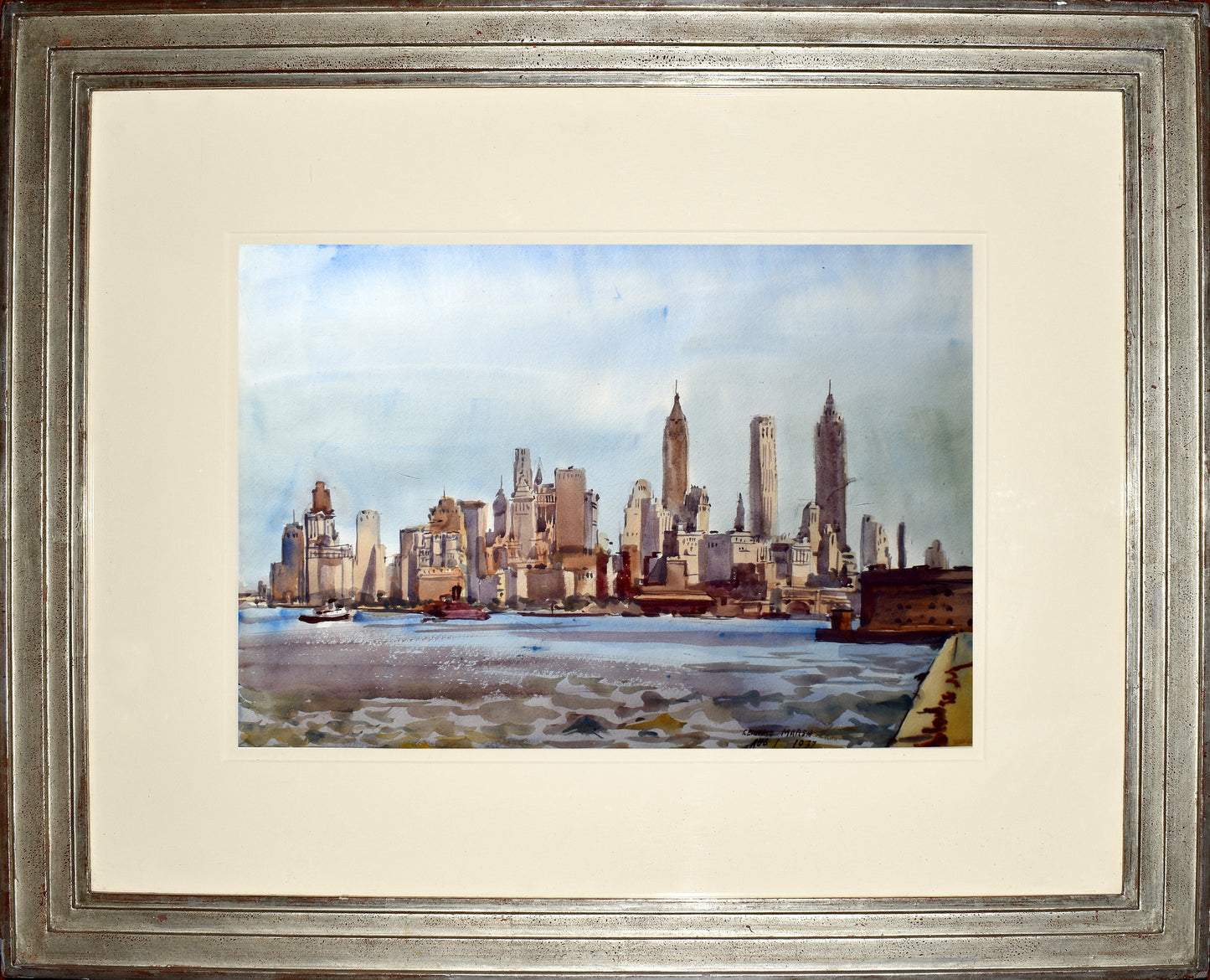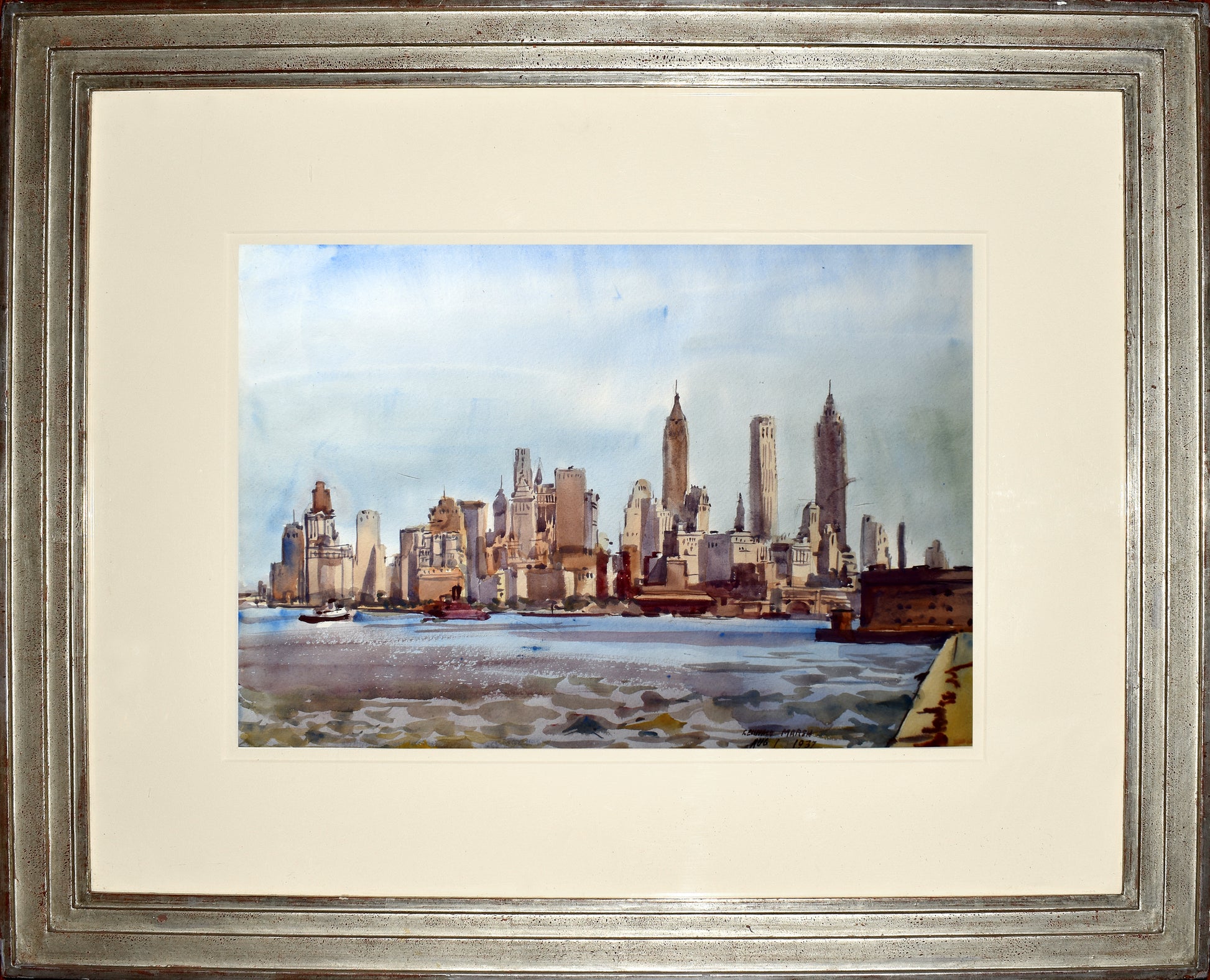from: U.S. City Views
REGINALD MARSH (1898-1954) New York Skyline
REGINALD MARSH (1898-1954) New York Skyline
Couldn't load pickup availability
REGINALD MARSH (1898-1954)
New York Skyline
Watercolor and pencil on paper
Paper size: 14” x 20”
Signed and dated, lower right:
Reginald Marsh Aug 1, 1937”; stamped lower right: “Marsh Collection”
Reginald Marsh is the most celebrated of the “Fourteenth Street School,” a group of dedicated urban realists who comprised the second generation of painters devoted to depicting the everyday life of the populace of New York City. In that, they succeeded the group later to become known as “The Ashcan School,” who developed around their leader, Robert Henri, and achieved fame especially with the exhibition of “The Eight,” held at New York’s Macbeth Galleries in February, 1908. The later painters tended more to emphasize rather individuals than urban scenes; along with Marsh, this group would include Isabel Bishop, the brothers Raphael and Moses Soyer, Kenneth Hayes Miller and others. Marsh’s fame was established beginning in the late 1920s and in 1943 he was made a full Academician of the National Academy of Design in New York. Marsh taught at the Art Students’ League from 1935 until his death in Dorset, Vermont in 1934.
Marsh was born in Paris to American parents; his father, Fred Dana Marsh, was a well-known painter and muralist also especially devoted to the urban scene; affluent, he more or less stopped painting in early middle age. The younger Marsh grew up in an artistic enclave in Nutley, New Jersey, where the family settled In 1900. After graduating from Yale University in 1920, Marsh began his career as a free-lance illustrator in New York City for the Daily News, Vanity Fair, the New Yorker, and other publications, while studying at the Art Students’ League. Much influenced by John Sloan and George Luks among “The Eight,” he also studied with Kenneth Hayes Miller, probably the most important of his teachers, who made a specialty of painting women shoppers and shopkeepers. Marsh went to Paris in 1925-26 for further instruction in order to achieve his ambition to render contemporary art in the style of the Old Masters. About 1929, Marsh began to use tempera rather than oil paint, and his search for older traditions is especially evident in his use of glazing. He was also an excellent watercolorist, and created vivid, large brush and ink drawings. Marsh chose as his most familiar subjects everyday figures on the street, in subways, bums, vaudeville and burlesque houses, scenes at Coney Island, and amusement parks, rendering these gritty themes in the procedural traditions of the Old Masters. A great admirer of Rubens and Delacroix, his figures are rendered broadly, even extravagantly in a baroque manner, with great exuberance and rowdiness. Though much of his visual material reflected the Depression era, Marsh remained aloof from political entanglements.
As early as 1927, Marsh undertook to add a very different theme to his repertoire-the shoreline of Manhattan Island, always devoid of figures. He had always had a strong interest in the New York waterfront, and created many panoramic views of Manhattan in oil, watercolor, tempera, as well as a group of eight etchings. The watercolor, New York Skyline, is one of the finest of these. He painted this subject over and over again with variations, though they almost always appear to be views from across the East River from Brooklyn or Queens, looking down from Midtown at the right, toward the Battery. Only a few appear to be painted from across the Hudson River Here, The Chrysler Building is the tall structure at the right, and the Empire State Building is the tallest structure near center. But one should probably not search too far for topographical accuracy. This series of paintings differ from one to the other, sometimes quite similar, sometimes differing widely, yet depicting some of the same structures. Here, for instance, the large structure on the near right would seem to suggest one of the forts located in Brooklyn, lower Manhattan, or even Governors Island. Other structures would seem to be missing here-such as the Woolworth Building; or omitted is the landmass of Roosevelt Island. Marsh was celebrating the city, not creating topographical views for atlases or tourists. He was enjoying the artist’s prerogative of choosing, moving, and creating the visual content of his work, all in celebration of the modern city.
Alternative versions might include the Brooklyn Bridge at the left, sometimes introducing a panorama of New York, at other times the primary feature, with the skyline as a backdrop. In New York Skyline here, a small tug appears at the very far left; in other versions tugs are more prominently placed, and during this period Marsh also painted close-up views of the tugs which obviously held interest for him. The apogee of his interest in tugs along the New York waterfront was reached in the murals he painted for New York Customs House in 1937, one of two WPA mural projects he undertook; the others were for the Post Office Building in Washington, D. C. In the New York murals, the tugboats loom large along with longshoremen, dock woks, ocean liners and cargo vessels. One might even suggest that the tug was, for Marsh, the equivalent of the everyday folk of his interior views of the city; just as he shunned the upper classes, so he generally omitted luxury liners. Nevertheless, these pictures celebrate New York City, perhaps purposely in the face of economic hardship, for the river streams smoothly, while the city’s tall buildings reach up into a placid blue sky. On his return from, Europe in 1926, Marsh wrote: “I felt fortunate indeed to be a citizen of New York, the greatest and most magnificent of all cities in a new and vital country whose history had scarcely been recorded in art...New York City was in a period of rapid growth, its skyscrapers thrilling by growing higher and higher. There was a wonderful waterfront with tugs and ships of all kinds…” New York Skyline is testimonial to Marsh’s celebratory sentiments and convictions.


